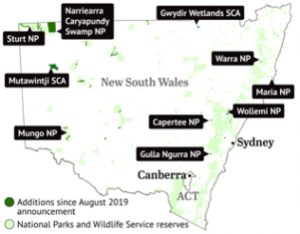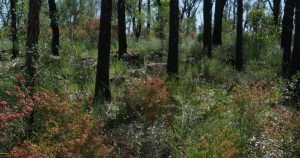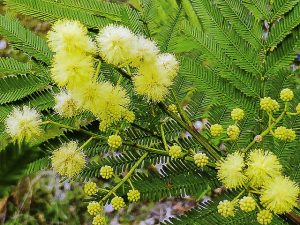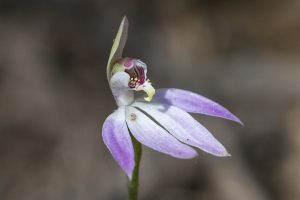APS NSW is a member of the Nature Conservation Council and Margery is our representative. Here is her update from the Annual Conference held 31 October 2020 via Zoom.
The principal activities of NCC during the year were to work for the conservation of nature, the protection of the environment and the attainment of an ecologically sustainable society.
NSW Environment Minister Matt Kean delivered the keynote address announcing a new target of adding 400,000 hectares of wildlife habitat to national parks by 2022, doubling the area he promised last August to protect.

Thousands of hectares of forests are now endangered by mining, logging and land clearing, and NSW has more than 1,000 threatened species.
The new national parks land includes the Narriearra Caryapundy Swamp National Park of 153,682 hectares, on land that was purchased in June, as well as an addition to the Sturt National Park of 17,479 hectares.
The expansion outlined above also includes additions to the Capertee National Park, the Maria National Park and Mungo National Park, as well as reclaiming Travelling Stock Reserves in the State’s far-northwest that are already managed by the National Parks and Wildlife Service.
This is good news; let’s hope he remains as Environment Minister in the State.
More good news is the NSW government’s policy of aiming for net zero greenhouse gas emissions by 2050 and support for renewable energy projects in spite of the Federal government’s refusal to make such commitments.
Chair of the NSW Parliamentary Inquiry into Koala Populations and their Habitat, Greens MP Cate Faehrmann, said that the government must do much more to protect koala habitat from logging, development and land clearing if koalas are going to be saved from extinction.
Cate noted that koala populations in NSW were already in a desperate state before the fires but now they are on the verge of extinction. Without major intervention the koala will almost certainly go extinct.

Furthermore, the Pilliga Forest in the state’s northwest and the Gardens of Stone near Lithgow are areas of outstanding conservation value threatened by gas and coal projects. These areas should be out of bounds, especially for fossil fuel projects that are feeding climate change and threatening our livelihoods and lifestyles.
NCC will undertake action, as described in the motions, on:
- Feral cats in national parks and feral horses in Kosciusko National Park
- Removal of mature native trees and associated shrubs and grasses in the Endangered Cumberland Plain Woodland in the Liverpool LGA
- Dumping heavy metal-contaminated coal ash in landfill
- The Federal Government’s plans to divert funds from the Clean Energy Finance Corporation (CEFC) and from the Australian Renewable Energy Agency (ARENA) for renewable projects into projects that will prolong the use of fossil fuels such as gas generators and carbon capture and storage
- Rural Fire Service proposed code to allow clearing of land 25m from a ‘rural’ boundary and requirement for public land holders to clear 25m into bushland where RFS deems it necessary
- Plus climate change, population growth, land clearing statute of limitations, mountain bike tracks and Katoomba Airfield.


Webinars are available that you can attend to learn more: ‘Cocktails, Controversy and Conservation’ usually occur fortnightly. Experts on a particular conservation topic present their findings. For example, on 15 January 2021, floodplain graziers, watching their equity move north, discussed the Darling Baaka River. The legal priority for water uses i.e. first environment, small farmers, then irrigators, is reversed in practice. The minutes of the conference also provide excellent background to the motions.
